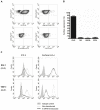Promiscuous binding of invariant chain-derived CLIP peptide to distinct HLA-I molecules revealed in leukemic cells
- PMID: 22563374
- PMCID: PMC3338516
- DOI: 10.1371/journal.pone.0034649
Promiscuous binding of invariant chain-derived CLIP peptide to distinct HLA-I molecules revealed in leukemic cells
Abstract
Antigen presentation by HLA class I (HLA-I) and HLA class II (HLA-II) complexes is achieved by proteins that are specific for their respective processing pathway. The invariant chain (Ii)-derived peptide CLIP is required for HLA-II-mediated antigen presentation by stabilizing HLA-II molecules before antigen loading through transient and promiscuous binding to different HLA-II peptide grooves. Here, we demonstrate alternative binding of CLIP to surface HLA-I molecules on leukemic cells. In HLA-II-negative AML cells, we found plasma membrane display of the CLIP peptide. Silencing Ii in AML cells resulted in reduced HLA-I cell surface display, which indicated a direct role of CLIP in the HLA-I antigen presentation pathway. In HLA-I-specific peptide eluates from B-LCLs, five Ii-derived peptides were identified, of which two were from the CLIP region. In vitro peptide binding assays strikingly revealed that the eluted CLIP peptide RMATPLLMQALPM efficiently bound to four distinct HLA-I supertypes (-A2, -B7, -A3, -B40). Furthermore, shorter length variants of this CLIP peptide also bound to these four supertypes, although in silico algorithms only predicted binding to HLA-A2 or -B7. Immunization of HLA-A2 transgenic mice with these peptides did not induce CTL responses. Together these data show a remarkable promiscuity of CLIP for binding to a wide variety of HLA-I molecules. The found participation of CLIP in the HLA-I antigen presentation pathway could reflect an aberrant mechanism in leukemic cells, but might also lead to elucidation of novel processing pathways or immune escape mechanisms.
Conflict of interest statement
Figures



Similar articles
-
Rheumatoid arthritis (RA)-associated HLA-DR alleles form less stable complexes with class II-associated invariant chain peptide than non-RA-associated HLA-DR alleles.J Immunol. 2001 Dec 15;167(12):7157-68. doi: 10.4049/jimmunol.167.12.7157. J Immunol. 2001. PMID: 11739539
-
Class II-associated invariant chain peptide down-modulation enhances the immunogenicity of myeloid leukemic blasts resulting in increased CD4+ T-cell responses.Haematologica. 2010 Mar;95(3):485-93. doi: 10.3324/haematol.2009.010595. Epub 2009 Nov 10. Haematologica. 2010. PMID: 19903675 Free PMC article.
-
Invariant chain as a vehicle to load antigenic peptides on human MHC class I for cytotoxic T-cell activation.Eur J Immunol. 2014 Mar;44(3):774-84. doi: 10.1002/eji.201343671. Epub 2013 Dec 27. Eur J Immunol. 2014. PMID: 24293164
-
Achieving stability through editing and chaperoning: regulation of MHC class II peptide binding and expression.Immunol Rev. 2005 Oct;207:242-60. doi: 10.1111/j.0105-2896.2005.00306.x. Immunol Rev. 2005. PMID: 16181341 Review.
-
Quality control of MHC class II associated peptides by HLA-DM/H2-M.Semin Immunol. 1999 Dec;11(6):391-403. doi: 10.1006/smim.1999.0197. Semin Immunol. 1999. PMID: 10625593 Review.
Cited by
-
Class II-associated invariant chain peptide as predictive immune marker in minimal residual disease in acute myeloid leukemia.Oncoimmunology. 2015 Jan 7;3(12):e941737. doi: 10.4161/21624011.2014.941737. eCollection 2014 Dec. Oncoimmunology. 2015. PMID: 25964856 Free PMC article.
-
Dendritic cell-based immunotherapy for myeloid leukemias.Front Immunol. 2013 Dec 31;4:496. doi: 10.3389/fimmu.2013.00496. Front Immunol. 2013. PMID: 24427158 Free PMC article. Review.
-
The correlation between Flt3-ITD mutation in dendritic cells with TIM-3 expression in acute myeloid leukemia.Blood Sci. 2021 Oct 18;3(4):132-135. doi: 10.1097/BS9.0000000000000092. eCollection 2021 Oct. Blood Sci. 2021. PMID: 35402842 Free PMC article. Review.
-
The potential applications of peptide-loading complex in cancer treatment.Front Immunol. 2025 Mar 3;16:1526137. doi: 10.3389/fimmu.2025.1526137. eCollection 2025. Front Immunol. 2025. PMID: 40098955 Free PMC article. Review.
References
-
- Fling SP, Arp B, Pious D. HLA-DMA and -DMB genes are both required for MHC class II/peptide complex formation in antigen-presenting cells. Nature. 1994;368:554–558. - PubMed
-
- Sloan VS, Cameron P, Porter G, Gammon M, Amaya M, et al. Mediation by HLA-DM of dissociation of peptides from HLA-DR. Nature. 1995;375:802–806. - PubMed
Publication types
MeSH terms
Substances
LinkOut - more resources
Full Text Sources
Medical
Research Materials

